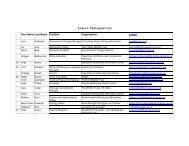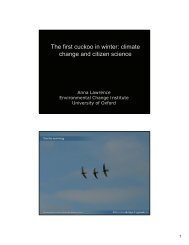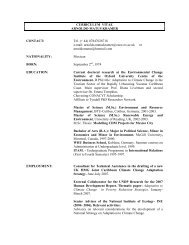ECI Annual Review 2006/2007 - Environmental Change Institute ...
ECI Annual Review 2006/2007 - Environmental Change Institute ...
ECI Annual Review 2006/2007 - Environmental Change Institute ...
Create successful ePaper yourself
Turn your PDF publications into a flip-book with our unique Google optimized e-Paper software.
much on numerical targets appear<br />
to be justified, and more attention is<br />
now being turned to the ecological<br />
impacts of such plans.<br />
Citizen science and community<br />
participation in Protected Area<br />
Management: a new approach for<br />
European Transition Countries<br />
Through its new and acceding<br />
member states the European Union<br />
has inherited an impressive array<br />
of protected areas and traditional<br />
agricultural landscapes with a<br />
wealth of biodiversity that has long<br />
been lost in western member states.<br />
New EU policy and changes in<br />
conservation philosophy provide<br />
openings and challenges for the<br />
central and eastern countries of<br />
Europe.<br />
These include the shift from<br />
centralised, hierarchical planning<br />
to participatory approaches<br />
which recognise the value of local<br />
knowledge, local commitment<br />
to place, and traditional customs<br />
and rules for protecting resources.<br />
Current participatory approaches<br />
rely either on a strong civil society<br />
sector (as in western Europe)<br />
or on rural communities who<br />
depend on their own resources and<br />
develop their own user rules (as in<br />
developing countries). New models<br />
of participatory conservation are<br />
therefore needed in post-socialist<br />
Europe.<br />
<strong>ECI</strong> is testing a model for<br />
community participation in<br />
protected areas in the northern<br />
Carpathians of Romania (the Rodna<br />
Mountains National Park) as part of<br />
a UK Government Darwin Initiative<br />
funded project. The approach<br />
recognises that participation is<br />
a new concept for many of the<br />
stakeholders, and therefore builds<br />
on existing relationships of trust<br />
within communities and schools.<br />
Activities include school children<br />
documenting local and traditional<br />
knowledge about the national park;<br />
schools forming ‘Friends of Rodna<br />
Mountains’ clubs, focusing on the<br />
specific interests of their school (eg,<br />
art); and Friends clubs contributing<br />
to the implementation of the<br />
management plan, by selecting<br />
specific plants or animals to study,<br />
with training in GIS (Geographical<br />
Information Systems). This also<br />
allows the park administration to<br />
consolidate, analyse and map all the<br />
data.<br />
This approach provides a model<br />
which is culturally and politically<br />
appropriate. It is being evaluated<br />
and adapted at interactive multistakeholder<br />
workshops nationally<br />
(Nov <strong>2006</strong>) and internationally (late<br />
<strong>2007</strong>).<br />
Community forests and small-scale<br />
forestry in Romania<br />
In common with other former-<br />
Soviet countries in Central and<br />
Eastern Europe, Romania initiated a<br />
process of ‘restitution’ – the return<br />
of state-appropriated property to<br />
pre-communist owners soon after<br />
the restoration of democracy.<br />
Restitution of forests is notoriously<br />
problematic and controversial,<br />
and <strong>ECI</strong> research is highlighting<br />
the difficult experiences of rural<br />
households, as they have coped<br />
with losing their forests to the<br />
state, regarding the forests as state<br />
property, and then engaging with<br />
the tangled restitution process to get<br />
their forests back.<br />
The diversity of these experiences<br />
provide signposts to the future to<br />
improve the social, institutional and<br />
ecological sustainability of forests,<br />
Key Publications<br />
Leader: Dr Anna Lawrence<br />
including:<br />
1. Establishing examples of good<br />
practice;<br />
2. Education and training:<br />
practical initiatives to integrate<br />
environmental and cultural<br />
values into school curricula;<br />
communication training for<br />
foresters; and management<br />
training for forest owners;<br />
3. Support for associations of<br />
forest owners to simplify<br />
administration and governance;<br />
4. Policy: taking account of the<br />
strong diversity of ownership<br />
and forest history; engaging<br />
with the more abstract, pronature<br />
values of city-based<br />
owners and public;<br />
5.<br />
Media: addressing the negative<br />
effects of foresters’ low selfesteem;<br />
and promoting the<br />
remarkable richness of cultural<br />
attachment to the forest found<br />
in rural Romania.<br />
Lawrence A. and Hawthorne W.<br />
(<strong>2006</strong>) Plant identification: creating<br />
user-friendly field guides<br />
for biodiversity management.<br />
Earthscan, London.<br />
Lawrence, A., Paudel, K.,<br />
Barnes, R. and Y. Malla. <strong>2006</strong>.<br />
Adaptive value of participatory<br />
biodiversity monitoring<br />
in community forestry, Nepal.<br />
<strong>Environmental</strong> Conservation<br />
33(4):325-334.<br />
Lawrence, A. (<strong>2006</strong>) “No<br />
personal motive?” Volunteers,<br />
biodiversity and the false<br />
dichotomies of participation.<br />
Ethics, Place and Environment 9<br />
(3): 279-298.<br />
1






